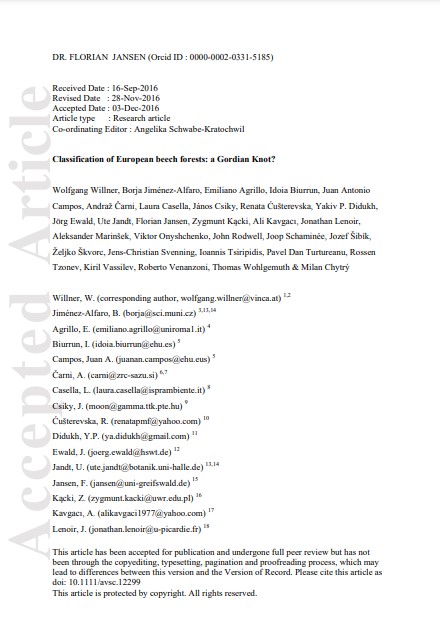Classification of European beech forests: a Gordian Knot?
Bosque Modelo:
Nova Forest Alliance
Temática:
Gestión forestal
Tipo de documento:
Artículo científico
Resumen
Questions What are the main floristic patterns in European beech forests? Which classification at the alliance and suballiance level is the most convincing? Location Europe and Asia Minor. Methods We applied a TWINSPAN classification to a data set of 24 605 relevés covering the whole range of Fagus sylvatica forests and the western part of Fagus orientalis forests. We identified 24 ‘operational phytosociological units’ (OPUs), which were used for further analysis. The position of each OPU along the soil pH and temperature gradient was evaluated using Ellenberg Indicator Values. Fidelity of species to OPUs was calculated using the phi coefficient and constancy ratio. We compared alternative alliance concepts, corresponding to groups of OPUs, in terms of number and frequency of diagnostic species. We also established formal definitions for the various alliance concepts based on comparison of the total cover of the diagnostic species groups, and evaluated alternative geographical subdivisions of beech forests. Results The first and second division levels of TWINSPAN followed the temperature and soil pH gradients, while lower divisions were mainly geographical. We grouped the 22 OPUs of Fagus sylvatica forests into acidophytic, meso-basiphytic and thermo-basiphytic beech forests, and separated two OPUs of F. orientalis forests. However, a solution with only two ecologically defined alliances of F. sylvatica forests (acidophytic vs basiphytic) was clearly superior with regard to number and frequency of diagnostic species. In contrast, when comparing groupings with three to six geographical alliances of basiphytic beech forests, respectively, we did not find a strongly superior solution. Conclusions We propose to classify F. sylvatica forests into 15 suballiances – three acidophytic and 12 basiphytic ones. Separating these two groups at alliance or order level was clearly supported by our results. Concerning the grouping of the 12 basiphytic suballiances into ecological or geographical alliances, as advocated by many authors, we failed to find an optimal solution. Therefore, we propose a multi-dimensional classification of basiphytic beech forests, including both ecological and geographical groups as equally valid concepts which may be used alternatively depending on the purpose and context of the classification.
Conclusions: We propose to classify Fagus sylvatica forests into 15 suballiances
–
3
acidophytic and 12 basiphytic ones. Separating these two groups at alliance or order level
was clearly supported by our results. Concerning the grouping of the 12 basiphytic
suballiances into ecological or geographical alliances, as advocated by many authors, we
failed to find an optimal solution. Therefore, we propose a multi
-dimensional classification of
basiphytic beech forests, including both ecological and geographical groups as equally valid
concepts which may be used alternatively depending on the purpose and context of the
classification.
Información Bibliográfica
Autor:
Willner, W; Jimenez-Alfaro, B; Agrillo, E; Biurrun, I; Campos, J;
Revista:
APPLIED VEGETATION SCIENCE
Año:
2017
N°:
3
País :
Canadá
Páginas:
494 - 512
Volumen:
20
Idioma:
Ingles
Palabras claves
Beech forest; Europe; Fagetalia sylvaticae; Fagion sylvaticae; Fagus sylvatica; Luzulo -Fagion sylvaticae; Syntaxonomy; TWINSPAN; Vegetation -plot database





